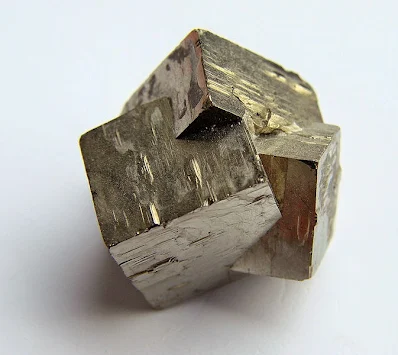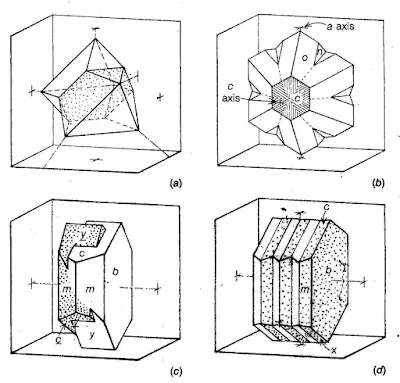Crystal Twinning: Types of Twinning With Photos
Twinning in Minerals and crystals
Twinning in minerals is a phenomenon in which two or more crystals of the same mineral grow together in a symmetrical fashion. This can happen during the initial growth of the crystal, or it can occur after the crystal has formed as a result of stress or temperature changes. The result is an intergrowth of two separate crystals in a variety of specific configurations.
Twinning can have a significant impact on the physical properties of minerals, including their hardness, cleavage, and optical properties. For example, twinned plagioclase feldspar is more resistant to weathering than untwinned plagioclase feldspar.
Formation and Causes of Twinning
There are a number of factors that can cause twinning in minerals. Some of the most common causes include:
Growth Twins: These twins form during crystal growth, when two or more crystals grow together in a symmetrical fashion. This can happen because the crystals share some of the same lattice points, or because they are growing under the same environmental conditions.
Transformation Twins: These twins form when a crystal undergoes a phase transformation, such as a change in temperature or pressure. This can cause the crystal to restructure itself into a new crystal structure with a different symmetry. For example, quartz can undergo a phase change from alpha-quartz to beta-quartz at high temperatures. If this phase change occurs unevenly, transformation twins can form.
Deformation Twins: These twins form when a crystal is subjected to stress or deformation. This can cause the atoms in the crystal to move into new positions, creating a twin boundary. For example, calcite twins can form when calcite is deformed during faulting.
A twin boundary or composition surface separates the two crystals. Crystallographers classify twinned crystals by a number of twin laws. These twin laws are specific to the crystal system. The type of twinning can be a diagnostic tool in mineral identification.
Twinning can often be a problem in X-ray crystallography, as a twinned crystal does not produce a simple diffraction pattern.
 |
| Pyrite Penetration Twin |
Types of Twinning
Contact Twinning
Contact twinning: Type of twinning with planar composition surfaces (twin planes) that separate two individual crystals.
Reflection twins: Subtype of contact twinning in which the two crystals are related by a reflection operation about the twin plane.
Rotation twins: Subtype of contact twinning in which the two crystals are related by a rotation operation about the twin plane.
 |
| Types of Twinning in Minerals. A rutile aggregate with a lot of twins from Simpelveld The Netherlands. Photo: © Fred Kruijen |
Penetration Twinning
Penetration Twinning: Type of twinning without well-defined composition surfaces. The two parts of the twin crystal may appear to be interpenetrating each other.
Intergrowth Twins: Subtype of penetration twinning formed when two crystals grow together in a symmetrical manner, but their crystal lattices do not perfectly interpenetrate.
Macle Twins: Subtype of penetration twinning formed when two crystals grow together in a perfectly symmetrical manner, with their crystal lattices completely interpenetrating.
Specific Types and Twin Laws
Merohedral Twins
Merohedral twins are a type of twinned crystal in which the twin operation (reflection, rotation, or inversion) is a symmetry element of the lattice but not of the crystal structure. The twin plane is a symmetry element of the original crystal, but it is not a symmetry element of the twinned crystal. This means that the twinned crystal has a higher symmetry than the individual crystals that make it up. This results in a twinned crystal with lower symmetry than the original crystal.
The term "merohedral" comes from the Greek words "meros" (part) and "hedra" (face), and it refers to the fact that the twin operation only involves a subset of the crystal's symmetry elements. Merohedral twins are most common in the trigonal, tetragonal, and hexagonal crystal systems.
Cyclic Twins
Cyclic Twins: This type of twinning is characterized by a series of twinned crystals that are arranged in a circular pattern. This results in a twinned crystal with the same symmetry as the original crystal. Cyclic twinning is common in minerals such as rutile and chrysoberyl.
Lamellar Twins
Lamellar twins are a type of crystal twin in which two or more crystals of the same mineral are intergrown in a parallel fashion. The twin lamellae (thin plates) are typically separated by a sharp twin boundary. Lamellar twins are found in a variety of minerals, including calcite, quartz, plagioclase feldspar, and gypsum.
Cruciform Twins
Cruciform twins are a type of twinned crystal in which two crystals of the same mineral grow together in a cross-like shape. The two crystals are typically perpendicular to each other, and they may be of equal or unequal size. This results in a twinned crystal that resembles a cross.
Cross Twins
Cross twins are a type of twinned crystal in which two crystals of the same mineral grow together in a cross-like shape. They are similar to cruciform twins, but the two crystals in a cross twin are not necessarily perpendicular to each other. Cross twins can be found in a variety of different minerals, including plagioclase feldspar, microcline feldspar, and staurolite.
Polysynthetic Twins
Polysynthetic twins are a type of twinned crystal in which two or more crystals of the same mineral grow together in a series of repeated layers. The layers are typically very thin, and they may be parallel or at a slight angle to each other. Polysynthetic twins are found in a variety of different minerals, including plagioclase feldspar, calcite, and pyroxene.
Carlsbad Twins
Carlsbad twins are a type of twinned crystal in which two crystals of the same mineral grow together with a 180° rotation about the crystallographic c-axis. This results in a mirror image relationship between the two halves of the twin. Carlsbad twins are most common in the alkali feldspars, such as orthoclase and microcline.
Dauphiné Twins
Dauphiné twins are a type of twinned crystal that is characterized by a 180° rotation of the twinned crystal about the crystallographic c-axis. This rotation results in a mirror image relationship between the two halves of the twin. This type of twinning is often characterized by a "butterfly" or "heart" shape.
Fishtail Twins
Fishtail twins are a type of twinned crystal in which two crystals of the same mineral grow together in a V-shaped or fishtail-shaped pattern. The twin plane is typically perpendicular to the c-axis of the crystal. Fishtail twins are most common in the mineral selenite, but they can also be found in other minerals, such as gypsum, calcite, and barite.
Re-entering Twins
Re-entering twins are a type of twinned crystal in which two crystals of the same mineral grow together in a way that creates a series of intersecting twin planes. This can result in a variety of different shapes and structures, depending on the type of mineral and the orientation of the twin planes. Re-entering twins are most common in the mineral calcite, but they can also be found in other minerals, such as aragonite and gypsum.
Hemimorphic Twins
Hemimorphic twins are a type of twinned crystal in which the two crystals are mirror images of each other, but with one half of each crystal being different from the other half. This can result in a variety of different shapes and structures, depending on the type of mineral and the orientation of the twin plane. Hemimorphic twins are most common in the minerals hemimorphite, pyrochlore, and tourmaline.
Albite Twins
Albite twins are a type of twinned crystal in which two crystals of the same mineral grow together in a mirror image relationship, with the twin plane being parallel to the albite law plane. This plane is perpendicular to the c-axis and the plane of the clinopinacoid. Albite twins are most common in the plagioclase feldspars, but they can also be found in other minerals, such as microcline feldspar and orthoclase feldspar.
 |
| Spinel cyclic twin from Pyin-Oo-Lwin District, Mandalay Division, Myanmar. |
Examples of Twinning in Minerals
There are many examples of twinning in minerals. Here are a few:
Calcite: Calcite twins are very common and can be found in a variety of rocks, including marbles, limestones, and metamorphic rocks. One common type of calcite twin is called a "polysynthetic twin," which is characterized by many thin twin lamellae (thin plates).
Quartz: Quartz twins are also common and can be found in a variety of rocks, including granites, pegmatites, and metamorphic rocks. One common type of quartz twin is called a "Dauphiné twin," which is characterized by two crystals that are intergrown in a mirror plane.
Plagioclase feldspar: Plagioclase feldspar twins are also common and can be found in a variety of igneous and metamorphic rocks. One common type of plagioclase feldspar twin is called an "Albite twin," which is characterized by two crystals that are intergrown in a parallel fashion.
Gypsum: Gypsum twins are also common and can be found in a variety of sedimentary rocks. One common type of gypsum twin is called a "swallowtail twin," which is characterized by two crystals that are intergrown in a V-shaped fashion.
Staurolite: Staurolite twins are less common, but they can be found in some metamorphic rocks. Staurolite twins are characterized by two crystals that are intergrown in a cross shape.
Fluorite: Fluorite twins are often found in hydrothermal veins and metamorphic rocks. One common type of fluorite twin is called a "penetration twin," which is characterized by two crystals that appear to be passing through each other.
Microcline: Microcline is a variety of potassium feldspar that is often found in igneous and metamorphic rocks. Microcline twins are characterized by their irregular shapes and broad twin boundaries.
 |
| Smooching Beryl twin Photo By Benjamin DeCamp |
Understanding twinning in minerals is crucial not only for mineral identification but also for unraveling the geological processes and conditions under which these minerals formed. The study of twinning contributes to our broader understanding of crystallography and mineralogical processes in Earth's crust.
Read also:



%20(1).webp)





